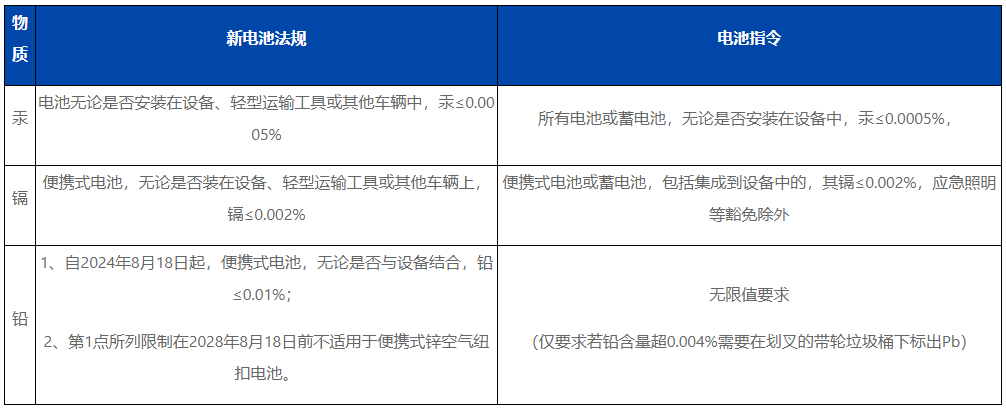On July 28, 2023, the Official Journal of the European Union issued Regulation (EU) 2023/1542 on Batteries and Waste Batteries, abolishing Directive 2006/66/EC. The new regulation came into effect on the 20th day after its publication, regulating the entire life cycle of batteries from production to reuse and recycling, ensuring their safety, sustainability, and competitiveness, and having a significant impact on battery related enterprises.
Applicable scope of battery regulations
The new battery regulations apply to all categories of batteries, which are divided into five categories based on their designed use: portable batteries, LMT batteries (light means of transport batteries), SLI batteries (starting, lighting, and ignition batteries), industrial batteries, and electric vehicle batteries.
Overview of battery regulatory requirements
The new battery regulation stipulates the requirements for sustainability and safety of batteries (including hazardous substances, Carbon footprint, recycled raw materials, electrochemical performance and durability, dismantlement and replaceability, etc.), requirements for labels, identifications and information (including general information, capacity information, QR code, trash can identification, battery health status and expected life, etc.), The consistency requirements for batteries (including presumption of compliance, commonly used specifications, conformity assessment, EU declaration of conformity, and CE marking), as well as regulations imposing due diligence obligations on economic operators who place batteries on the market or put them into use, green public procurement requirements when purchasing batteries or products containing batteries, as well as requirements for extended producer responsibility, waste battery management, and electronic passports.
Comparison of new and old requirements for controlling harmful substances in batteries
The new regulations mention that in addition to meeting the hazardous substance requirements specified in Annex XVII of the EU REACH regulation and the EU ELV directive, batteries must not contain substances restricted by the following table:

Requirements for updating battery label identification
General information: All batteries are labeled with basic battery information, including manufacturer information, battery type, chemical composition, other harmful substances except for lead, cadmium, mercury, and key raw materials;
Capacity information: Rechargeable portable batteries, LMT batteries, and SLI batteries should be labeled with capacity information, and non rechargeable portable batteries should also be labeled with the minimum average duration and labeled as' non rechargeable ';
QR code: Batteries should be accompanied by a QR code, which contains different information for different types of batteries;
Battery separate collection symbol: trash can identification. For batteries with cadmium exceeding 0.002% or lead containing 0.004%, corresponding chemical element symbols should be added under the trash can identification;
CE marking: All batteries should be labeled with a CE marking before being placed on the market.
Other requirements of the new regulations
The new regulations also stipulate requirements on the Carbon footprint of batteries, the content of recovered cobalt, lead, lithium and nickel in active substances, electrochemical performance and durability, disassembly and replaceability, etc. The specific requirements for different types of batteries are different, and the compliance date is also different. For example, Carbon footprint requirements for electric vehicle batteries, rechargeable industrial batteries and LMT batteries are as follows:
1. Electric vehicle batteries, rechargeable industrial batteries with a capacity greater than 2 kilowatt hours, and LMT batteries shall draft a Carbon footprint statement, which shall at least include the administrative information about the manufacturer, the battery model, the geographical location of the battery manufacturer, the identification number of the EU battery compliance statement, and other information.

2. Electric vehicle batteries, rechargeable industrial batteries and LMT batteries with a capacity greater than 2 kilowatt hours must be labeled with obvious, legible and indelible labels, indicating the Carbon footprint of the battery, and indicating the Carbon footprint performance level of the relevant battery model corresponding to each manufacturing plant.

3. The technical documents mentioned in Annex VIll of electric vehicle batteries, rechargeable industrial batteries with a capacity greater than 2 kWh and LMT batteries shall prove that the life cycle Carbon footprint value of the relevant battery model of each manufacturer is lower than the maximum threshold specified in the authorization act.









 Shen Gongwang Security: 44030602006947
Shen Gongwang Security: 44030602006947